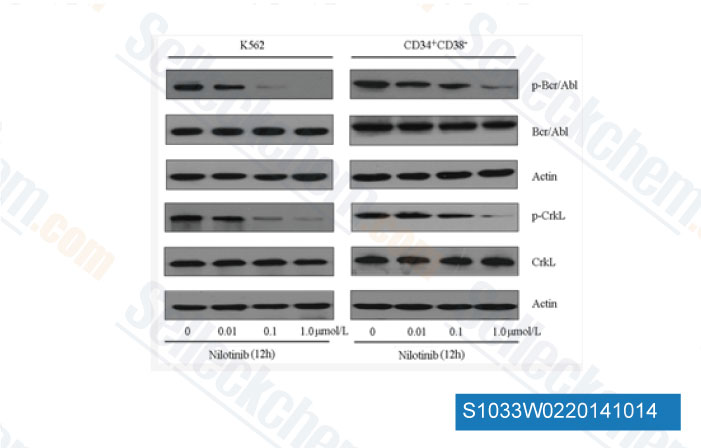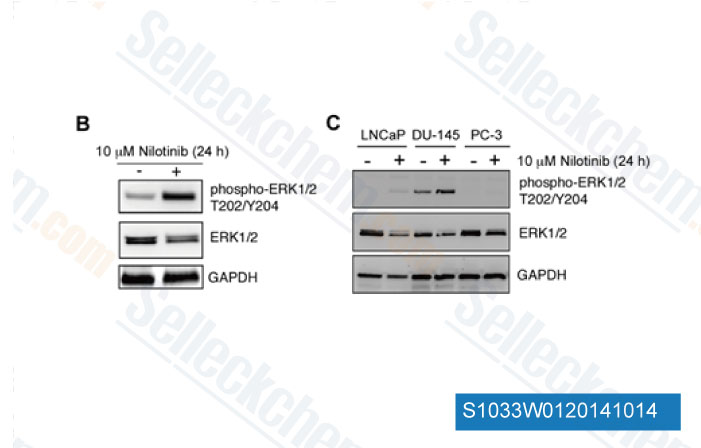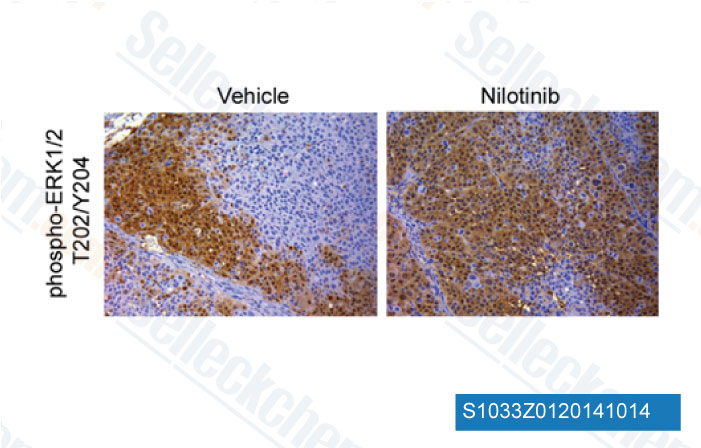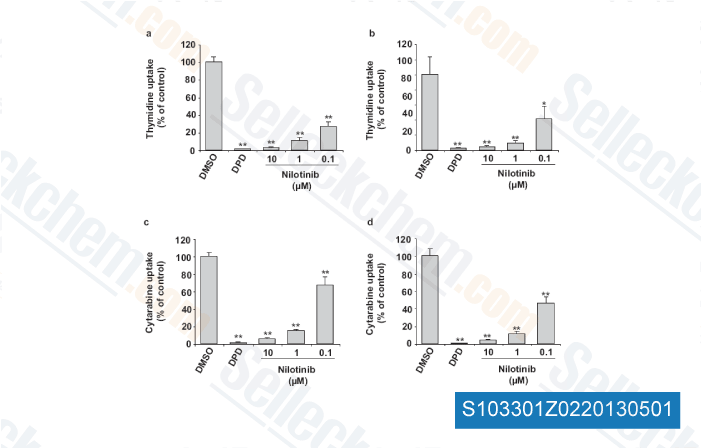|
Toll Free: (877) 796-6397 -- USA and Canada only -- |
Fax: +1-832-582-8590 Orders: +1-832-582-8158 |
Tech Support: +1-832-582-8158 Ext:3 Please provide your Order Number in the email. |
Technical Data
| Formula | C28H22F3N7O |
||||||||||
| Molecular Weight | 529.52 | CAS No. | 641571-10-0 | ||||||||
| Solubility (25°C)* | In vitro | DMSO | 13 mg/mL (24.55 mM) | ||||||||
| Water | Insoluble | ||||||||||
| Ethanol | Insoluble | ||||||||||
| In vivo (Add solvents to the product individually and in order) |
|
||||||||||
|
* <1 mg/ml means slightly soluble or insoluble. * Please note that Selleck tests the solubility of all compounds in-house, and the actual solubility may differ slightly from published values. This is normal and is due to slight batch-to-batch variations. * Room temperature shipping (Stability testing shows this product can be shipped without any cooling measures.) |
|||||||||||
Preparing Stock Solutions
Biological Activity
| Description | Nilotinib is a selective Bcr-Abl inhibitor with IC50 less than 30 nM in Murine myeloid progenitor cells. This compound induces autophagy through AMPK activition. | ||
|---|---|---|---|
| Targets |
|
||
| In vitro | Nilotinib inhibits proliferation, migration, and actin filament formation, as well as the expression of α-SMA and collagen in activated HSCs. This compound induces apoptosis of HSCs, which is correlated with reduced bcl-2 expression, increases p53 expression, cleavage of PARP, as well as increases expression of PPARγ and TRAIL-R. It also induces cell cycle arrest, accompanied by increased expression of p27 and downregulation of cyclin D1. Interestingly, this chemical not only inhibits activation of PDGFR, but also TGFRII through Src. It significantly inhibits PDGF and TGFβ-simulated phosphorylation of ERK and Akt. Furthermore, PDGF- and TGFβ-activated phosphorylated form(s) of Abl in human HSCs are inhibited by this agent. [2] This inhibitor suppresses most imatinib-resistant Bcr-Abl mutations, except for T315I. [3] It inhibits PDGF-DD-mediated ERK1/2 activation, basal and PDGF-DD-mediated activation of PDGFRβ and Akt, and schwannoma proliferation. This compound is more potent than imatinib, exerting its maximal inhibitory effect at concentrations lower than steady-state trough plasma levels. [4] It also significantly reduces the expression levels of the genes for TGF-β1 and platelet-derived growth factor (PDGF). This treatment also significantly inhibits the PDGF-induced proliferation of lung fibroblasts. [5] It inhibits the proliferation of Ba/F3 cells expressing p210- and p190-Bcr-Abl, or K562 and Ku-812F cells with IC50 values ≤12 nM. [6] | ||
| In vivo | Nilotinib reduces collagen deposition and α-SMA expression in CCl4 and BDL-induced fibrosis. This compound could induce HSC undergoing apoptosis, which is correlated with downregulation of bcl-2. [2] It attenuates the extent of lung injury and fibrosis. This therapy significantly reduces the levels of hydroxyproline on days 14 and 21, which is accompanied by decreased expression levels of transforming growth factor (TGF)-β1 and PDGFRβ. [5] This chemical prolongs survival of mice injected with Bcr-Abl-transformed hematopoietic cell lines or primary marrow cells, and prolongs survival in imatinib-resistant CML mouse models. [6] | ||
| Features | A selective inhibitor of native and mutant Bcr-Abl. |
Protocol (from reference)
| Cell Assay:[4] |
|
|---|---|
| Animal Study:[6] |
|
References
|
Customer Product Validation

-
Data from [ Molecules , 2014 , 19, 3356-75 ]

-
Data from [ Urol Oncol , 2014 , 0.1016/j.urolonc.2014.06.001 ]

-
Data from [ Urol Oncol , 2014 , 0.1016/j.urolonc.2014.06.001 ]

-
Data from [ Leukemia Res , 2012 , 36, 1311-1314 ]
Selleck's Nilotinib Has Been Cited by 159 Publications
| Nilotinib attenuates vascular pathology in experimental cerebral malaria [ Blood Adv, 2025, bloodadvances.2024015364] | PubMed: 39993234 |
| CDK8/19 inhibition attenuates G1 arrest induced by BCR-ABL antagonists and accelerates death of chronic myelogenous leukemia cells [ Cell Death Discov, 2025, 11(1):62] | PubMed: 39955308 |
| Nbeal2 Inactivation Triggers Abl1 Stabilisation and Dysregulated Subcellular Localisation of the Multi-Drug-Resistant Protein MDR1 (ABCB1) in Mast Cells [ Immunology, 2025, NONE] | PubMed: 41111259 |
| Electrochemical assay for the quantification of anticancer drugs and their inhibition mechanism [ Methods, 2025, 241:13-23] | PubMed: 40345605 |
| Discovery of non-steroidal aldo-keto reductase 1D1 inhibitors through automated screening and in vitro evaluation [ Toxicol Lett, 2025, 406:31-37] | PubMed: 39988211 |
| Structural Identification of Major Molecular Determinants for Phosphotyrosine Recognition in Tyrosine Kinases Reveals Tumour Promoting and Suppressive Functions [ bioRxiv, 2025, 2025.06.10.658871] | PubMed: 40661594 |
| Activating p53 abolishes self-renewal of quiescent leukaemic stem cells in residual CML disease [ Nat Commun, 2024, 15(1):651] | PubMed: 38246924 |
| Comprehensive multi-omics analysis reveals WEE1 as a synergistic lethal target with hyperthermia through CDK1 super-activation [ Nat Commun, 2024, 15(1):2089] | PubMed: 38453961 |
| The molecular basis of Abelson kinase regulation by its αI-helix [ Elife, 2024, 12RP92324] | PubMed: 38588001 |
| Satellite cell-derived TRIM28 is pivotal for mechanical load- and injury-induced myogenesis [ EMBO Rep, 2024, 10.1038/s44319-024-00227-1] | PubMed: 39143258 |
RETURN POLICY
Selleck Chemical’s Unconditional Return Policy ensures a smooth online shopping experience for our customers. If you are in any way unsatisfied with your purchase, you may return any item(s) within 7 days of receiving it. In the event of product quality issues, either protocol related or product related problems, you may return any item(s) within 365 days from the original purchase date. Please follow the instructions below when returning products.
SHIPPING AND STORAGE
Selleck products are transported at room temperature. If you receive the product at room temperature, please rest assured, the Selleck Quality Inspection Department has conducted experiments to verify that the normal temperature placement of one month will not affect the biological activity of powder products. After collecting, please store the product according to the requirements described in the datasheet. Most Selleck products are stable under the recommended conditions.
NOT FOR HUMAN, VETERINARY DIAGNOSTIC OR THERAPEUTIC USE.
